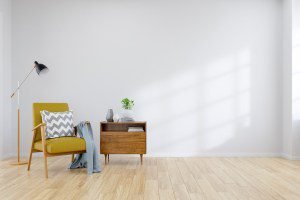Minimalist style homes are characterised by their simplicity, functionality and use of basic geometric forms. The colour palette for these homes tends to be neutral and subdued, focusing on creating a calming and harmonious space. This article will explore the colours that work well in a minimalist style home and provide some important considerations for choosing the right hues.
See also: Best colours to help with sleep
Colours that compliment minimalist house decor
White
White is the most prevalent colour in minimalist homes. It exudes a sense of cleanliness and freshness, providing a perfect backdrop for other elements in the home. Its reflective properties also help make the space look larger and brighter, which is especially useful in smaller homes or apartments.
Grey
Grey is another popular choice for minimalist homes. It is available in various tones, spanning from pale to deep hues. Light greys can serve as a warmer alternative to white, while dark greys can add an element of depth and intrigue to a room. Grey is also a versatile colour that can be paired with a variety of other hues.
Beige
Beige and other off-white colours are excellent for creating a warm and cosy atmosphere in minimalist homes. When paired with pure white, these tones can create a sophisticated, layered look that adds depth to the room while still keeping the space light and airy.
Black
While it might seem too bold or stark for a minimalist home, black can be incredibly effective when used strategically. It can serve as a striking contrast to lighter colours, adding an element of drama and modernity to a space. This could be achieved through black furniture, accents, or even an accent wall.
Pastels
Soft pastel colours like pale pink, mint green, or baby blue can inject a subtle touch of colour into a minimalist home without being too overpowering or distracting. These colours are perfect for adding a little personality and warmth to a space and they pair beautifully with neutral tones.
Natural hues
Colours inspired by nature, such as stone, sand and wood, can evoke a sense of tranquillity in a minimalist home. These colours complement natural materials like wood and stone, which are often used in minimalist design. Using these hues can help create a connection with the outdoors, enhancing the sense of peace and serenity in the home.
Important considerations
When choosing colours for a minimalist home, you should also consider the following:
Lighting
The amount and type of lighting in your home can significantly affect how a colour looks. Always test colours in different lighting conditions before making a decision.
Space
Light colours can make a small space appear larger, while dark colours can add depth and intimacy to a large space.
Mood
The colours you choose can influence the mood of the room. Light colours are typically associated with tranquillity and freshness, while dark colours are often seen as more dramatic and luxurious.
Consistency
To keep the minimalist look, it’s important to maintain a consistent colour scheme throughout the home. This doesn’t mean every room has to be the same colour, but they should all coordinate in some way.
Textures and patterns
In a minimalist home, textures and patterns can add interest and depth to a room without adding clutter. Consider using these elements to add more character to your colour scheme.
Balance
While a minimalist home often features a simple colour palette, this doesn’t mean the space has to be monotonous. Strive for a balance between neutrals and accent colours to create a harmonious and visually interesting space.
Personal preference
Above all, choose colours that you love. Your home should be a reflection of your personal style and taste.
Creating a minimalist home doesn’t mean sticking to a completely monochrome colour palette. While neutral tones are a hallmark of minimalist design, there’s room for colour and personal expression. By considering the tips and guidelines outlined in this article, you can create a minimalist home that is not only stylish and modern but also uniquely yours.
FAQs
Can I use bold colours in a minimalist home?
While minimalist design typically features a neutral colour palette, there's no rule that says you can't use bold colours. The key is balance and restraint. If you want to use a bold colour, consider using it as an accent rather than the main colour in a room.
How can I add colour to my minimalist home without it looking cluttered?
One way to add colour to a minimalist home is through accents. This could be a vibrant piece of art, a colourful rug, or brightly coloured cushions. The crucial aspect is to maintain simplicity and avoid excessive embellishment.
Can I use patterns in a minimalist home?
Yes, patterns can be used in a minimalist home as long as they're not too busy or overwhelming. Subtle patterns that use the same colour palette as the rest of the room can add interest without adding clutter.
How do I choose the right white paint for my minimalist home?
White paint comes in a variety of shades and undertones. Some are cooler, while others are warmer. The best way to choose the right white is to test several options in your space to see how they look in different light conditions.
Can I mix different neutrals in a minimalist home?
Yes, mixing different neutrals can add depth and interest to a minimalist space. For example, you could mix white with beige or grey. The essential thing is to ensure that the overall appearance remains unified.
How many colours should I use in a minimalist home?
There's no set rule, but a typical minimalist colour palette might include one main colour (usually a neutral) and one or two accent colours.
Do I have to stick to a specific colour palette to achieve a minimalist look?
No, the most important thing is to keep the palette simple and balanced. While neutrals are common in minimalist design, you can use any colour as long as it's used with restraint and consistency.
| Got any questions or point of view on our article? We would love to hear from you. Write to our Editor-in-Chief Jhumur Ghosh at [email protected] |

Upasana Mandhata, currently in her final year of Law, is pursuing a BA LLB Degree at VIT University Chennai. Her interest in content creation dates back to her school and college years when she discovered a writing passion. Drawing from personal experiences, her writing style has been shaped by her journey and encounters. She enjoys experimenting with new recipes, painting, or swimming while clocking out of work time.











